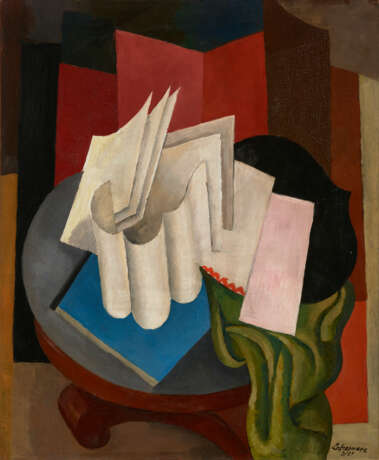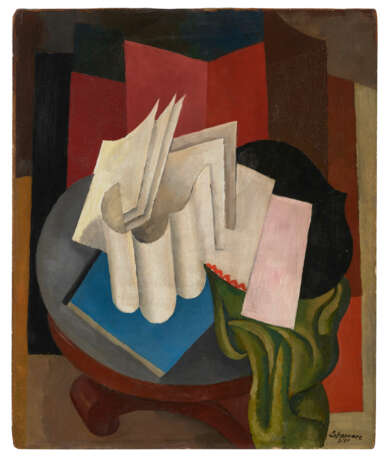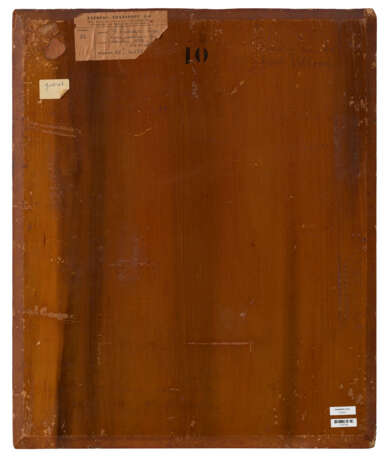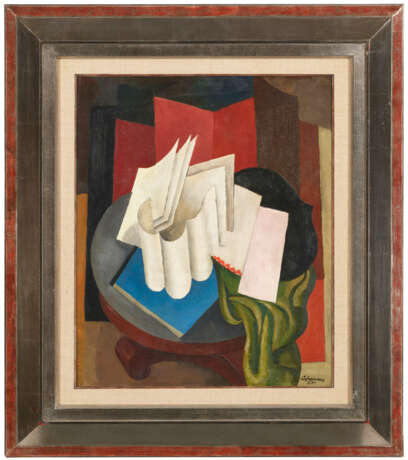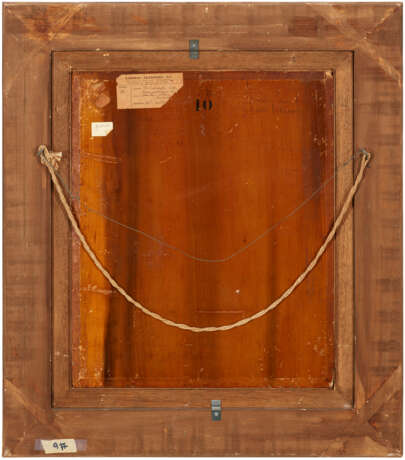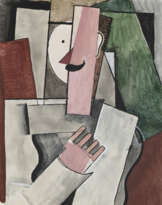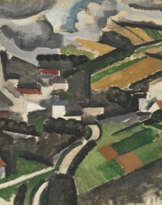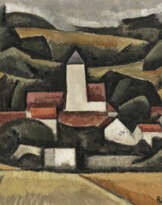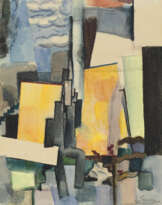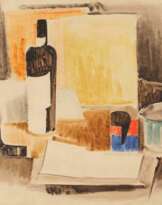ID 1178542
Lot 115 | Roger de La Fresnaye (1885-1925)
Estimate value
€ 60 000 – 80 000
Les Feuilles blanches
signé et daté 'La Fresnaye 3⁄21' (en bas à droite)
huile sur panneau
54.9 x 45.3 cm.
Peint en mars 1921
signed and dated 'La Fresnaye 3⁄21' (lower right)
oil on panel
21 5⁄8 x 17 7⁄8 in.
Painted in March 1921
Provenance
Madame André Mare, Paris (avant 1935 et jusqu'à au moins 1962).
Collection particulière, France (par descendance et jusqu'à au moins 1969).
Acquis par le propriétaire actuel avant 1986.
Literature
P. Chadourne, 'Notes sur Roger de La Fresnaye', in Cahiers d'Art, Paris, 1928, p. 323 (illustré).
E. Nebelthau, Roger de La Fresnaye, Paris, 1935 (illustré).
G. Seligman, Roger de La Fresnaye, With a catalogue raisonné, New York, 1969, p. 205, no. 331 (illustré).
Exhibited
Paris, Petit Palais, Les Maîtres de l'Art Indépendant, 1895-1937, juin-octobre 1937, no. 25 (titré 'Nature morte').
Paris, Galerie E. Druet, Roger de La Fresnaye, mars 1938.
Paris, Maison de la Pensée française, Roger de La Fresnaye, février-mars 1949, p. 12, no. 93 (daté '1922').
Paris, Musée National d'Art Moderne, Roger de la Fresnaye, juillet-octobre 1950, no. 74.
Lyon, Musée de Lyon, Roger de la Fresnaye, 1951, no. 28.
Paris, Galerie de l'Institut, Roger de la Fresnaye, novembre-décembre 1962, no. 12.
Further details
"En opposition à l'orthodoxie plus cérébrale des toiles cubistes tardives, souvent plus réfléchies que vues, La Fresnaye arrangeait et réarrangeait minutieusement les objets réels, utilisant même des feuilles de papier pour simuler les plans et les zones de couleur géométriques. […] Il ne pouvait peindre que ce qu'il voyait, mais il voyait avec l'œil d'un poète et sa vision transformait des objets plébéiens d'usage quotidien en arrangements lyriques de distinction et de grâce."
G. Seligman, Roger de la Fresnaye, Neuchâtel, 1969, p. 36.
Membre clé de la Section d’Or fondée en 1911, et adepte du cubisme dès la première heure, Roger de La Fresnaye abandonne cependant les tons sourds du cubisme classique à partir de 1913. Il considère, comme d’autres, que le cubisme pur se durcit en une méthode systématique et statique, et que celle-ci tend à vider la peinture de son humanité traditionnelle. L’artiste, quant à lui, préfère promouvoir les couleurs et mettre en avant leur harmonie et leur expressivité. Son style évolue donc et se rapproche davantage de celui de Robert Delaunay avec lequel il partage le goût des courbes et des sphères mais surtout celui de la couleur.
Parallèlement à ce choix de la couleur, la présente œuvre témoigne de l’intérêt de La Fresnaye pour l’un de ses thème favoris : la nature morte. Ce sujet lui donne l’occasion de s’épanouir pleinement et de témoigner de sa précision et de son originalité. La Fresnaye procède de manière systématique et compose des compositions complexes avec des objets glanés dans son atelier : bouteille, équerre, encrier, feuilles, cartons, etc… Souvent, en effet, l’artiste utilise des cartons de couleurs, comme ici le carré jaune, pour donner une impression de planéité à ses natures mortes et se rapprocher du collage. À l’inverse des objets disposés sur la table qu’il transforme sous le prisme du cubisme, les carrés de cartons colorés ne sont quant à eux pas déstructurés par l'artiste, insufflant ainsi à ses natures mortes un sentiment d’abstraction.
Véritable contemplateur de la réalité, La Fresnaye déduit de ses observations des images essentiellement graphiques et exprime les choses de façon schématique. S’inspirant directement de la réalité et articulant lui-même ses compositions, l’artiste réalise des œuvres qui ne sont pas sans rappeler le monde de la photographie et de la mise en scène.
Dans ses natures mortes, La Fresnaye témoigne de sa capacité à synthétiser les volumes et intégrer les recherches chromatiques basées sur le contraste simultané pratiqué par ses maîtres. Il s’affranchit du cubisme classique et théorique et s'aventure davantage vers un art plus coloré et moins imbriqué. En effet, si ses compositions demeurent résolument figuratives, il fut le premier à injecter une couleur intense dans les formes plates, pour certaines à peine ébauchées, s’orientant vers un cubisme davantage orphique. À l’instar des maîtres cubistes, l’artiste n’optera jamais pour une analyse radicale de la forme.
Comme l'exprimait Clement Greenberg, si La Fresnaye a absorbé les théories relatives au cubisme entreprises par Braque et Picasso, il a réussi à « le rendre élégant […] et joyeux » (C. Greenberg, The collected essays and criticism, Arrogant purpose, Chicago et Londres, 1986, vol. II, p. 39.).
“In contrast to the more cerebral orthodoxy of later Cubist paintings, which often relied more upon the mental than the visual, La Fresnaye meticulously arranged and rearranged real objects, even using sheets of paper to simulate geometric planes and areas of colour. In fact, he once stated himself that he had so little imagination that he could only paint what he saw, yet he saw with the eye of a poet and his vision transformed ordinary, everyday objects into lyrical arrangements of distinction and grace.”
G. Seligman, Roger de la Fresnaye, Neuchâtel, 1969, p. 36.
A key member of the Section d’Or artists’ collective founded in 1911 and a follower of Cubism from the outset, Roger de La Fresnaye nevertheless abandoned the muted tones of classical Cubism starting in 1913. Like others, he felt that pure Cubism was hardening into a static, mechanical method, and that it tended to strip painting of its traditional humanity. La Fresnaye rather promoted the use of colours, highlighting their harmony and expressivity. His style thus evolved and approached that of Robert Delaunay, with whom he shared a taste for curves and spheres, but particularly for colour.
Alongside this choice of colour, the present work bears witness to La Fresnaye’s love of the still life — one of his favourite themes. The still life enabled him to fully express himself and to demonstrate his precision and originality. La Fresnaye worked systematically and created complex compositions with objects found in his studio: a bottle, a set square, an inkwell, leaves, cardboard, etc. Indeed, the artist often used coloured cardboard, such as the yellow square here, to give an impression of flatness to his still lifes and even approximate collage. Unlike the objects on the table, which he transforms through the Cubist lens, the coloured cardboard squares are not deconstructed by the artist, thus lending his still lifes a sense of abstraction.
A genuine observer of reality, La Fresnaye deduced essentially graphic images from his observations and expressed things schematically. Taking his inspiration directly from the real world and structuring his compositions himself, the artist created works of art that recall the world of photography and mise-en-scène.
In his still lifes, La Fresnaye demonstrates his ability to synthesise volume and incorporate colour development based on the simultaneous contrast practised by his masters. He broke away from classical theoretical Cubism, venturing more towards a more colourful and less layered art. Indeed, while his compositions remain resolutely figurative, he was the first to inject bold colour into flat forms, some barely sketched, moving towards a more Orphic Cubism. Like the Cubist masters, the artist never opted for a radical analysis of form.
As Clement Greenberg put it, if La Fresnaye absorbed the theories of Cubism pioneered by Braque and Picasso, he succeeded in rendering the movement "elegant […] and joyful" (C. Greenberg, The collected essays and criticism, Arrogant purpose, Chicago & London, 1986, vol. II, p. 39).
| Artist: | Roger de la Fresnaye (1885 - 1925) |
|---|---|
| Applied technique: | Oil on panel |
| Genre: | Still life |
| Auction house category: | Paintings, Watercolors, Drawings, Paintings |
| Artist: | Roger de la Fresnaye (1885 - 1925) |
|---|---|
| Applied technique: | Oil on panel |
| Genre: | Still life |
| Auction house category: | Paintings, Watercolors, Drawings, Paintings |
| Address of auction |
CHRISTIE'S 9 Avenue Matignon 75008 Paris France | ||||||||||||||
|---|---|---|---|---|---|---|---|---|---|---|---|---|---|---|---|
| Preview |
| ||||||||||||||
| Phone | +33 (0)1 40 76 85 85 | ||||||||||||||
| Fax | +33 (0)1 40 76 85 86 | ||||||||||||||
| Conditions of purchase | Conditions of purchase | ||||||||||||||
| Shipping |
Postal service Courier service pickup by yourself | ||||||||||||||
| Payment methods |
Wire Transfer | ||||||||||||||
| Business hours | Business hours
|
